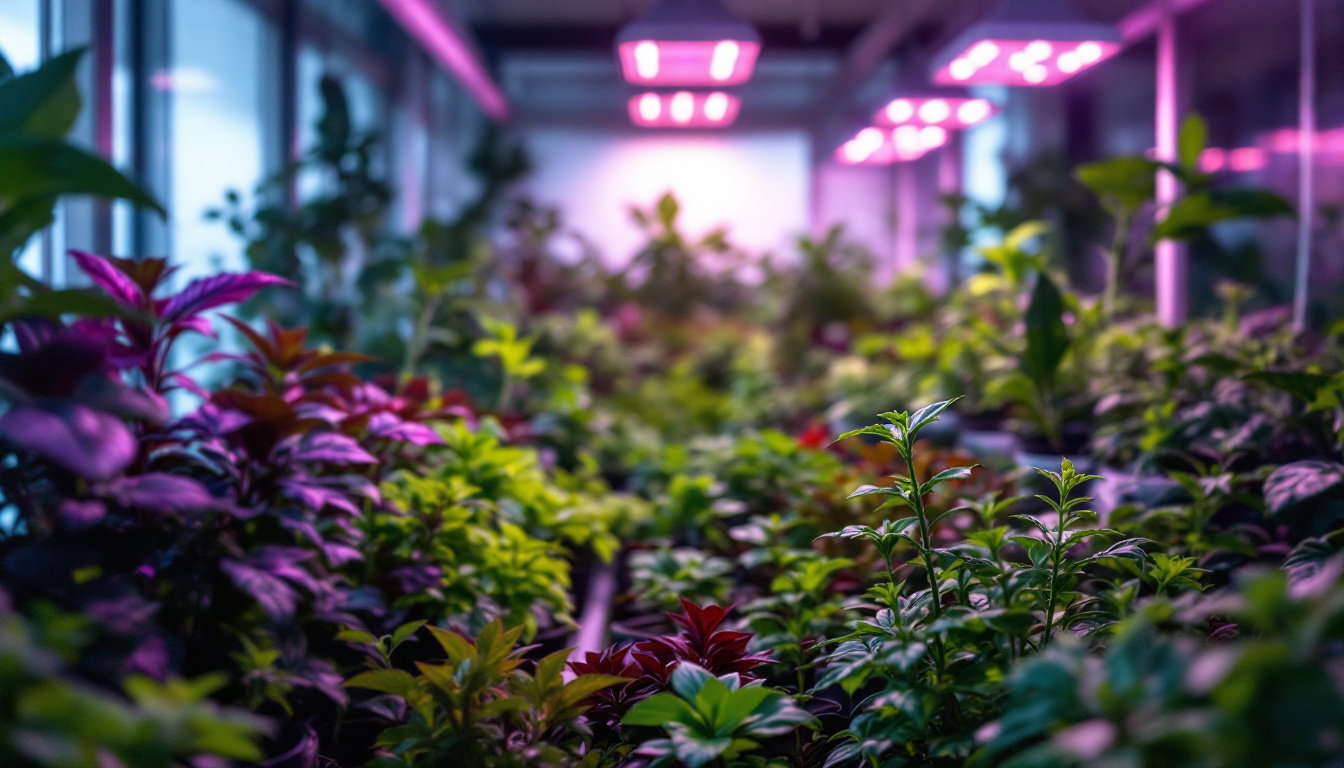
In the ever-evolving world of horticulture and agriculture, the role of lighting has become increasingly significant. As more growers turn to indoor and greenhouse cultivation, the demand for specialized lighting solutions has surged. For lighting contractors, understanding the nuances of grow lights is not just beneficial; it is essential. This article delves into the importance of grow lights, the various types available, and the critical role lighting contractors play in this burgeoning field.
Grow lights have revolutionized the way plants are cultivated, allowing for year-round production regardless of external weather conditions. This advancement is particularly crucial for urban farming, where space is limited, and traditional farming methods may not be feasible. With the rise of vertical farming and hydroponics, grow lights have become an essential tool for maximizing space efficiency and optimizing crop yields in confined environments.
Moreover, grow lights enable growers to optimize plant growth by providing the specific wavelengths of light that plants need for photosynthesis. This targeted approach not only enhances plant health but also boosts yields, making it a vital consideration for any grower. By adjusting the intensity and duration of light exposure, growers can simulate natural seasonal changes, further promoting healthy plant development and potentially leading to multiple harvests within a single year.
Plants rely on light for photosynthesis, the process through which they convert light energy into chemical energy. Different stages of plant growth require different light spectrums. For instance, seedlings thrive under blue light, which promotes vegetative growth, while flowering and fruiting stages benefit from red light, which encourages blooming and fruit development. This understanding of light spectrum requirements allows growers to create tailored lighting schedules that mimic natural sunlight patterns, thus enhancing the overall growth process.
By utilizing grow lights, contractors can help growers tailor their lighting setups to meet the specific needs of various plants, ensuring optimal growth and health. Understanding these requirements is crucial for contractors aiming to provide effective lighting solutions. Additionally, advancements in LED technology have made it possible to create full-spectrum grow lights that can cater to a wide range of plant species, making it easier for growers to diversify their crops without needing multiple lighting systems.
One of the most significant advantages of using grow lights is the ability to cultivate plants year-round. In regions with harsh winters or limited sunlight, grow lights can supplement natural light, allowing for continuous production cycles. This capability not only increases the profitability of growers but also enhances food security in urban areas. As consumers become more conscious of the environmental impact of food transportation, locally grown produce becomes increasingly desirable, and grow lights play a crucial role in meeting this demand.
Lighting contractors play a pivotal role in designing systems that maximize light efficiency and coverage, ensuring that every plant receives the right amount of light regardless of the season. By incorporating smart technology, such as timers and light sensors, these systems can be further optimized to reduce energy consumption and operational costs. This not only benefits the growers financially but also aligns with sustainable practices, making agriculture more eco-friendly and reducing the carbon footprint associated with food production. As the agricultural landscape continues to evolve, the integration of advanced grow light technologies will undoubtedly shape the future of farming in urban settings.
Understanding the different types of grow lights is essential for lighting contractors. Each type has its own advantages and disadvantages, making it crucial to match the right light to the specific needs of the plants being grown.
LED grow lights have gained immense popularity due to their energy efficiency and long lifespan. They emit specific wavelengths of light that can be tailored to the needs of different plants, making them versatile for various growth stages.
Additionally, LED lights produce less heat compared to traditional lighting options, reducing the risk of overheating plants. This feature allows for closer placement of lights, further enhancing light intensity and coverage. Moreover, many LED systems come equipped with adjustable spectrums, allowing growers to switch between vegetative and flowering phases with ease. This adaptability not only optimizes plant growth but also contributes to energy savings, as growers can fine-tune their lighting setups based on the specific requirements of their crops.
Fluorescent lights, particularly T5 and T8 tubes, are another popular choice among growers. They are relatively inexpensive and provide a good spectrum for seedling growth. However, they may not be as effective for flowering plants, which require more intense light.
Lighting contractors should consider the specific requirements of the plants when recommending fluorescent lights, as their effectiveness can vary significantly based on the growth stage. Additionally, fluorescent lights are often favored for their low heat output and ability to cover a large area, making them ideal for starting seedlings or growing leafy greens. However, growers should also be aware that while fluorescent lights can be effective, they may need to be supplemented with other light sources as plants mature and their light requirements increase.
HID lights, including Metal Halide (MH) and High-Pressure Sodium (HPS) lamps, have been staples in the horticultural lighting industry for years. They are known for their high light output and efficiency, making them suitable for larger growing spaces.
However, HID lights generate significant heat and require additional cooling solutions. Lighting contractors must be prepared to design systems that mitigate this heat while maximizing light distribution. Furthermore, HID lights are often used in conjunction with reflective surfaces to enhance light penetration and distribution throughout the growing area. This combination can lead to improved yield and plant health, as the intense light can stimulate robust growth. Additionally, growers should consider the photoperiod needs of their plants, as HID systems can be set on timers to simulate natural day/night cycles, promoting healthy flowering and fruiting behaviors in photoperiod-sensitive species.
As the demand for grow lights continues to rise, lighting contractors must consider several key factors when designing lighting systems for growers. Understanding these considerations can enhance service offerings and improve client satisfaction.
Different plants have varying light spectrum requirements. Understanding the specific needs of each plant type is crucial for contractors. For example, leafy greens may require more blue light, while fruiting plants benefit from red light.
Contractors should be equipped with knowledge about the light spectrum and how to create a balanced setup that meets the needs of diverse plant species. This expertise can set contractors apart in a competitive market. Moreover, staying updated on the latest research regarding photomorphogenesis—the way plants grow and develop in response to light—can further enhance a contractor’s ability to tailor lighting solutions. By understanding how different wavelengths affect plant growth stages, contractors can provide more precise recommendations, ensuring that growers achieve optimal yields.
Energy efficiency is a significant concern for growers, especially those operating on tight budgets. Lighting contractors should prioritize energy-efficient solutions that provide optimal light output without excessive energy consumption.
By recommending LED lights or other energy-efficient options, contractors can help growers save on electricity bills while still achieving excellent results. This focus on cost savings can enhance the overall value of the contractor’s services. Additionally, contractors could explore smart lighting technologies that allow growers to adjust light intensity and duration based on specific plant needs or growth cycles. Such systems not only contribute to energy savings but also promote sustainable practices, appealing to environmentally conscious clients.
effective system design is crucial for maximizing the benefits of grow lights. Contractors must consider factors such as light placement, intensity, and coverage to ensure that all plants receive adequate light.
Additionally, proper installation is essential to prevent issues such as light burn or insufficient coverage. Lighting contractors should be well-versed in installation techniques and best practices to deliver high-quality results for their clients. Furthermore, incorporating adjustable mounting systems can provide flexibility, allowing growers to modify light positioning as plants mature. This adaptability not only enhances plant health but also demonstrates the contractor’s commitment to providing long-term solutions that evolve with the grower’s needs. Understanding the integration of automation and control systems can also add significant value, enabling growers to monitor and adjust their lighting setups remotely for optimal performance.
The future of grow lighting is bright, with advancements in technology paving the way for more efficient and effective solutions. As the industry evolves, lighting contractors must stay informed about emerging trends and innovations.
smart lighting systems that integrate with automation technologies are becoming increasingly popular. These systems allow growers to control light schedules, intensity, and spectrum through mobile apps or computer interfaces.
Lighting contractors who embrace smart technology can offer clients enhanced control over their growing environments, leading to improved plant health and productivity.
Ongoing research into plant responses to different light spectrums is likely to yield new insights that can inform lighting design. Contractors should remain engaged with industry research and developments to provide the most up-to-date recommendations to their clients.
By staying informed, lighting contractors can position themselves as experts in the field, fostering trust and loyalty among growers.
As the demand for indoor and greenhouse cultivation continues to grow, the importance of specialized lighting solutions cannot be overstated. Lighting contractors play a crucial role in this landscape, providing expertise and guidance to help growers achieve optimal results.
By understanding the various types of grow lights, considering key factors in system design, and staying informed about industry trends, lighting contractors can enhance their service offerings and contribute to the success of their clients. The future of grow lighting is promising, and those who adapt to the changing landscape will undoubtedly thrive in this dynamic field.
Ready to elevate your lighting game and empower your grow-light installations? Look no further than LumenWholesale for an unbeatable selection of spec-grade lighting products. Our commitment to quality and affordability ensures that you can provide your clients with the most advanced and cost-effective lighting solutions. With free shipping on bulk orders, you can stock up on the best lighting products without the worry of hidden fees. Don’t let middleman markups dim your project’s potential. Choose LumenWholesale for the perfect blend of quality, affordability, and convenience. Wholesale Lighting at the Best Value is just a click away—transform your lighting approach today!

Discover essential insights into surface mounted LED lights tailored for lighting contractors.

Illuminate your understanding of workshop light bulbs with this insightful article tailored for lighting contractors.

Discover the evolution of the first invented light bulb and explore essential best practices for modern lighting contractors.

Discover strategies to boost profitability in lighting installations with innovative electrical lighting solutions.